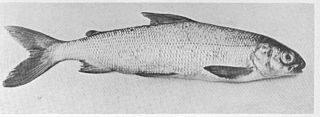
Mackerel is a common name applied to a number of different species of pelagic fish, mostly from the family Scombridae. They are found in both temperate and tropical seas, mostly living along the coast or offshore in the oceanic environment.

Herring are various species of forage fish, belonging to the order Clupeiformes.

The African spoonbill is a long-legged wading bird of the ibis and spoonbill family Threskiornithidae. The species is widespread across Africa and Madagascar, including Botswana, Kenya, Mozambique, Namibia, South Africa, and Zimbabwe.

The white tern or common white tern is a small seabird found across the tropical oceans of the world. It is sometimes known as the fairy tern, although this name is potentially confusing as it is also the common name of Sternula nereis. Other names for the species include angel tern and white noddy in English, and manu-o-Kū in Hawaiian. in the Cook Islands, it is known as the kakaia. The little white tern, previously considered a subspecies of the white tern, is now recognised as a separate species.

The powan is a kind of freshwater whitefish endemic to two lochs in Scotland, Loch Lomond and Loch Eck. It has been successfully introduced in two other sites, Loch Sloy and the Carron Valley Reservoir.
The schelly is a living fresh water fish of the salmon family, endemic to four lakes in the Lake District, England. Its taxonomy is disputed with some recognizing it as a distinct species and others as a variant of the widespread Eurasian whitefish species Coregonus lavaretus. It is present in Brothers Water, Haweswater, Red Tarn and Ullswater, and the population seems stable in all of these except for Haweswater where it seems to be declining. The main threats it faces are seen to be water abstraction and cormorants, and the fish-eating birds are being culled from Haweswater. The International Union for Conservation of Nature has rated the conservation status of this fish as "Vulnerable".

The bottlenose skate, spearnose skate, or white skate is a species of skate in the family Rajidae. It is a benthic fish native to the coastal eastern Atlantic Ocean. Due to overfishing, it has been depleted or extirpated in many parts of its former range in the northeastern Atlantic and the Mediterranean Sea, and is now endangered.

Avicennia alba is a species of tropical mangrove in the family Acanthaceae. It is found growing in coastal and estuarine locations in India, Southeast Asia, Australia, and Oceania.

An anchovy is a small, common forage fish of the family Engraulidae. Most species are found in marine waters, but several will enter brackish water, and some in South America are restricted to fresh water.
Metzia is a genus of freshwater ray-finned fish belonging to the family Xenocyprididae, the East Asian minnows or sharpbellies. The fishes in this genus are found in Asia. The genus is named in honor of the American ichthyologist Charles William Metz of Stanford University.

Sonneratia alba is a mangrove tree in the family Lythraceae. The specific epithet alba is from the Latin meaning 'white', referring to the flowers.
Metzia formosae is a species of freshwater ray-finned fish belonging to the family Xenocyprididae, the East Asian minnows or sharpbellies. It is considered "least concern" by the IUCN Red List. It inhabits small rivers in still or slow-moving waters and can be found in Yunnan, China and Taiwan. The mitogenome of Metzia formosae measures 16,614 base pairs, comprising 13 genes responsible for coding proteins, 22 transfer RNA genes, 2 ribosomal RNA genes, and a noncoding control region.
Metzia hautus is a species of freshwater ray-finned fish belonging to the family Xenocyprididae, the East Asian minnows or sharpbellies. This fish is only known from the Cả River in Viet Nam.
Metzia lineata is a species of freshwater ray-finned fish belonging to the family Xenocyprididae, the East Asian minnows or sharpbellies. It inhabits medium-sized and small rivers of southern China, Taiwan, Laos, and Vietnam and is considered "least concern" by the IUCN Red List. It has a maximum standard length of 10.0 centimetres (3.9 in).
Metzia longinasus is a species of freshwater ray-finned fish belonging to the family Xenocyprididae, the East Asian minnows or sharpbellies. This species is found in the Hongshui-He River in Guangxi.
Metzia mesembrinum is a species of freshwater ray-finned fish belonging to the family Xenocyprididae, the East Asian minnows or sharpbellies. It was endemic to Taiwan but has been introduced to Singapore. This species has a maximum published standard length of 4.8 cm (1.9 in). The species was found on Taiwan proper until the 1920s, when its range was reduced to the outlying island of Kinmen.
Metzia parva is a species of freshwater ray-finned fish belonging to the family Xenocyprididae, the East Asian minnows or sharpbellies. This species is known only from the Cheng-jiang River, a tributary of Hongshui He River in the Pearl River basin in Guangxi.

Nipponocypris sieboldii is a species of freshwater ray-finned fish belonging to the family Xenocyprididae, the East Asian minnows or sharpbellies. that is endemic to Japan. It has a maximum length of 12.5 centimetres (4.9 in).
Lycenchelys alba is a species of marine ray-finned fish belonging to the family Zoarcidae, the eelpouts.










